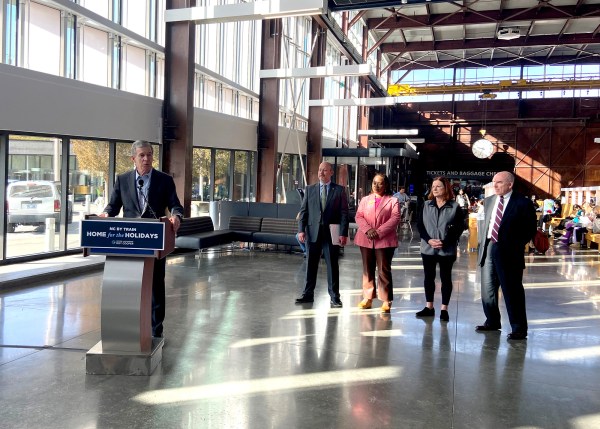The electric vehicle transition in North Carolina is well on its way, with new factories announced, charging stations rising up, and some 85,000 plug-ins now on state roads, exceeding a goal set by Gov. Roy Cooper to help combat climate change.
Yet for all their importance, electric vehicles won’t zero out carbon pollution from the transportation sector on their own. Doing so, experts warn, also requires reducing dependence on automobiles overall — no matter their source of fuel.
In North Carolina, it’s a task not easily said and even harder to do.
The state’s current goal for reducing vehicle travel miles falls far short of what’s necessary. And legislators have severely limited funds for non-road projects, forcing local communities who simply want bike lanes or better sidewalks to go their own way.
Still, advocates say they’re cautiously optimistic about the final eight months of the Cooper administration, beginning with a new target for reducing vehicle dependence they expect this month.
“I’m feeling hopeful that N.C. is going to adopt a more ambitious goal,” said Megan Kimball, senior attorney with the Southern Environmental Law Center.
‘Very modest’
Cooper, a Democrat in his second and final term who’s prioritized clean energy action, has issued a raft of climate executive orders and forged compromise with the Republican-led legislature on the clean energy transition.
A 2018 edict focused on the power sector, initiating a clean power plan that culminated in a bipartisan law, House Bill 951, which requires Duke Energy to zero out its climate-warming pollution by midcentury.
In 2022, the governor issued a similar order centered on transportation, today the largest source of global warming pollution in the state and the nation.
The Clean Transportation Plan called for in that proclamation “would be similar to the Clean Energy Plan,” Cooper said at the time. “That was an amazing stakeholder process that led to the passage of House Bill 951.”

Yet no such law has materialized — or is even on the horizon. That’s reflected in the state’s latest Greenhouse Gas Inventory, showing the transportation sector on pace to be just 39% cleaner in 2050, compared to Cooper’s goal of 100%.
Part of the problem may be the Clean Transportation Plan itself, issued a year ago. Advocates say the blueprint lacks concrete goals and action items. Most glaring: it didn’t set a goal for reducing vehicle miles of travel.
And while the state’s Department of Transportation, as part of a court settlement, later established a per capita 2.5% reduction target by 2040, doubling to 5% by 2050, officials acknowledge it lacks ambition.
“We recognize that it’s a very modest goal,” Heather Hildebrandt, the department’s supervisor for statewide initiatives, said during a recent webinar. “We wanted to set those targets at something we thought we could attain.”
Hildebrandt and her colleagues noted that other states’ targets far exceed that of North Carolina, with Washington state leading the pack with a goal of cutting per capita passenger vehicle miles in half by midcentury.
One Rocky Mountain Institute study found that even with a near 30-fold increase in electric vehicle registrations across the country by 2030, a 20% cut in per capita vehicle miles would still be necessary to meet climate targets.
Similarly, the organization’s North Carolina-specific analysis concluded that curbing miles traveled by 20% would reduce transportation sector pollution by a tenth , while saving households thousands of dollars and avoiding over 400 traffic deaths a year.
That’s why advocates are pushing a new vehicle miles reduction goal of at least 20% per capita. Officials say a more aggressive benchmark is forthcoming.
“This target will be more ambitious and help inform policy,” Hildebrandt told Energy News Network in an email.
Still, goal setting can only go so far. “That’s different than actually taking action,” Kimball said.
‘That’s on us’
A potpourri of incentives and educational campaigns — like Bike-to-Work Day and promoting telework — could help solve the problem on the margins.
But these initiatives skirt the reality that in much of the state, North Carolinians have no practical alternative to driving. There simply isn’t the infrastructure in the form of bike lanes, sidewalks, and reliable and convenient public transit.
At an event last year touting train ridership, Cooper noted the mismatch.
“I’ve talked to a lot of people who would definitely use public transportation if they could rely on it — and if it were more convenient and less expensive,” the governor said. “That’s on us to create more opportunities for them.”
Indeed, experts have found the solutions to be relatively straightforward: Curtail funding for new or expanded roadways and support alternative modes instead. Pair investments in public transit with inducements for dense, affordable housing nearby.
“In our own research, it’s pretty obvious [what] policies make the change,” said Anna Zetkulic, a senior associate at Rocky Mountain Institute.
But executing that relatively simple formula is complex, and the barriers are myriad.
Policy leaders have devoted most of the last century to making North Carolina “The Good Roads State” to promote economic development and alleviate poverty. And even as the benefits of four-lane roads in the state’s every corner reach diminishing and geographically disparate returns — and the injustice of replacing Black neighborhoods with bypasses increasingly recognized — many politicians continue to embrace road construction above all else.
Earlier this year, GOP House Speaker Tim Moore and Senate leader Phil Berger criticized Charlotte’s plan to invest in light rail, bike lanes, and other alternate transportation modes. While acknowledging some need for alternatives, they said the city should pursue a “roads first” agenda.
Such talk isn’t idle: to raise sales taxes to pay for a multi-billion-dollar transportation plan, Charlotte, like all local governments, needs permission from a legislature controlled by Republicans, many who represent rural areas.
“Some of the things that we often hear from transportation advocates in urban areas are probably difficult for [legislators] to vote for,” Berger said, per Axios Charlotte.
The legislature doesn’t just weigh in on case-by-case proposed sales tax increases. A 2013 law helps ensure that nearly all state transportation dollars go to highways and roads. The statute also prevents the state from funding bike- or pedestrian-only projects.
“If you’re widening a road or building a new road, you can tack on a sidewalk or a bike lane,” said Kimball. “But if it’s not tied to a road project, it can’t be funded.”
State Sen. Julie Mayfield, an Asheville Democrat, sought last year to remove the prohibition with an amendment to the budget.
“I’m sure many of you have enjoyed walking on a greenway,” she told her colleagues. “This would simply open up more funding for bike and pedestrian projects across the state.”
The measure failed on party lines.
Compounding the political problem for advocates of transportation alternatives, special interests promoting road construction tend to be well-connected and well-heeled. There’s no equivalent lobby for biking and walking.
And though decades of research show that adding another lane to a highway does not reduce congestion, and instead invites more cars to the road and ultimately creates more traffic problems, that result is counterintuitive for both voters and the politicians they elect.
“Traditionally, highway engineers treat traffic like it’s a liquid that needs to flow through a pipe,” said Miguel Moravec, another senior associate with Rocky Mountain Institute. “But in reality, traffic is more like a gas that expands.”
Even adequately funded efforts to improve public transit and orient residential and commercial development around it have faced challenges.
A Raleigh plan to build the state’s first Bus Rapid Transit system in an historically Black neighborhood, for instance, has drawn critics who worry that the project, if coupled with zoning measures encouraging density, will displace long-time residents and echo destructive highways of the past.
Powerful institutions and not-in-my-backyard interests have also bristled at intensive transit projects, such as when Duke University torpedoed a Durham-Chapel Hill light rail proposal in 2019. Charlotte remains the state’s only city with a light-rail line.
‘Real transportation choices’
But alternative transportation advocates do have cause for hope.
To help address concerns about gentrification and displacement, Raleigh is piecemealing new zoning rules around its first Bus Rapid Transit line, perhaps serving as a model for future transit-oriented development.
Political leaders in Chapel Hill and Durham have moved on from the failed light rail proposal, with many now working on local solutions and to change the law to allow more funding for bike and pedestrian options.
Train ridership between Charlotte and Raleigh hit records in 2022 and again last year as Amtrak increased frequency of service. A single-month record in October of over 65,000 passengers was aided by a special stop at the State Fairgrounds.
The federal Climate Pollution Reduction Program — a product of the 2022 Inflation Reduction Act — allows the state of North Carolina, the Triangle and Charlotte to compete for $4.6 billion in grants for a number of projects, including funding transportation alternatives.
And while reducing auto dependence is easiest in the state’s most densely populated metro areas, there are also ample opportunities in small towns looking to revitalize their main streets, and in medium-sized cities, too.
According to Rocky Mountain Institute, 45% to 56% of car trips in Wilmington, Winston-Salem, and Greensboro are five miles or less.
“Half of trips are in this sweet spot,” said Moravec, “where micro-mobility transit like e-bikes and other alternatives could better serve people and cut pollution.”
Perhaps above all, advocates are heartened by the shorter-term, non-climate related benefits of reducing our auto dependence, including less air pollution, fewer traffic fatalities, and more savings for households who spend less fueling and maintaining cars.
Greensboro, the third largest city in the state, plans to be car optional by 2040 – where driving is a choice, not a necessity. Hanna Cockburn, the city’s transportation director, said that goal was only partially informed by its aims on climate.
“That’s a piece of it, but it’s more nuanced than that,” Cockburn said. “I think there’s a recognition that thriving, successful cities have real transportation choices.”











